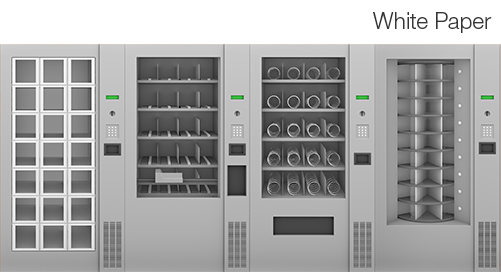Understanding the humanoid robot market and its potential
The humanoid robot market is poised to explode over the next decade. Forecasts from Goldman Sachs Research suggest it could become a $36 billion market by 2035, and more recently Citi GPS has forecasted the market to reach $7 trillion by 2050. A variety of factors will play into the potential of the humanoid robot market, including widespread research and development across the globe, access to lower cost components, and increased demand for humanoid robots across industries. Read on to learn more about the state of the humanoid robot market and the future of this innovative technology.
What is a humanoid robot?
A humanoid robot is simply a robot designed to resemble the human body, and act in a manner similar to humans. Humanoid robots aren’t limited in the same way most traditional robots are, as they have greater freedom of movement and can interact with their environment in much the same way humans do. This makes their application potential near-limitless, and is a large part of why the industry is poised for rapid growth over the next decade.
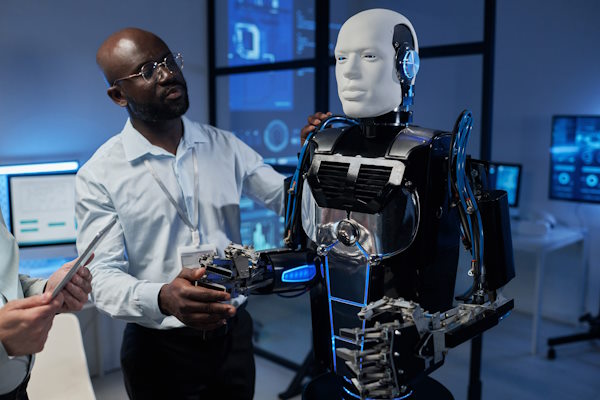
Key players in the humanoid robot market
The humanoid robot market is made up of companies across various different roles, from AI and software developers to component providers, integrators, and top-level manufacturers. Below are some of the key players in the industry currently.
AI developers
Advanced AI models are the future of humanoid robots. AI allows these robots to analyze and understand their surroundings and ultimately react to them in a much more human way. This is exactly what companies like OpenAI and Google (Google AI, DeepMind) have been working on developing for years.
Robotics company Figure is already making use of OpenAI’s technology to develop speech-to-speech reasoning for its humanoid robot, Figure 02. The ultimate goal will be for artificial intelligence to allow Figure robots to learn and develop new skills over time to create advanced general purpose robots.
Component providers
NVIDIA, a longtime producer of computing technology and inventor of the GPU, is poised to become the leading producer of advanced componentry for humanoid robots. Their latest project — called Project GR00T — is built on NVIDIA’s own Blackwell graphics architecture. GR00T is a foundational model for humanoid robots, and is designed to drive “breakthroughs in robotics and embodied AI”.
NVIDIA has already partnered with companies like Google DeepMind, Tesla, OpenAI and Meta to get Blackwell in the hands of as many industry leaders as possible. With most of these companies already involved in the humanoid robot market, it’s a near-certainty NVIDIA will be one of the most influential players across the entire industry for the foreseeable future.
Manufacturers
Humanoid robot manufacturers are some of the most well-known players in the humanoid robot market. Companies like Boston Dynamics, Agility Robotics, and Hanson Robotics are some of the biggest across the entire humanoid robot market, though each is taking a different approach to the development of humanoid robots.
Boston Dynamics may be the most popular humanoid robot manufacturer, in large part due to a robust online presence and various viral videos of its humanoid “Atlas” and quadruped “Spot” robots. The four-legged Spot is already available for purchase, and has been used to great success in warehousing, manufacturing, and construction applications.
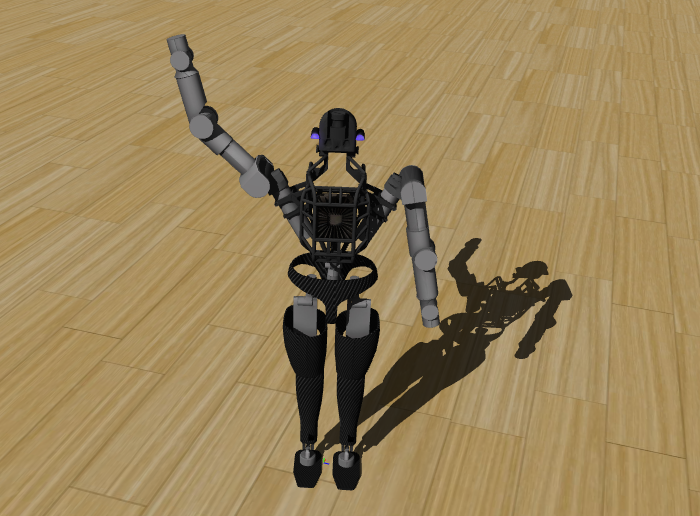
Olivier Michel, CC BY-SA 4.0, via Wikimedia Commons
Agility Robotics has already developed a commercially available humanoid robot, dubbed “Digit”. Aimed primarily at manufacturing, warehousing, and logistics, Digit is intended to be an answer to rapidly growing labor shortages in these industries.
Hanson Robotics is the company behind Sophia, a humanoid robot most well known for its realistic looks and complex facial expressions. The goal of Hanson Robotics is to “[create] socially intelligent machines that enrich the quality of our lives”. An alpha version of Sophia is currently available for research, academic, and B2B applications.
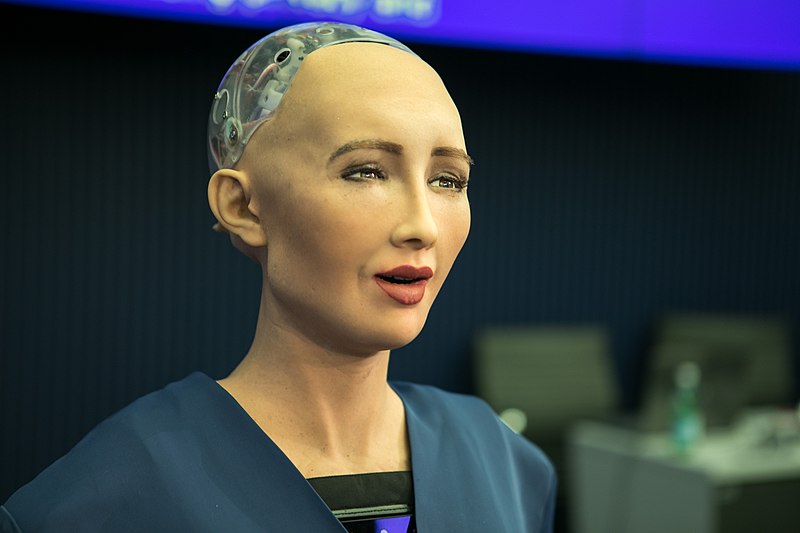
Challenges facing the humanoid robot market
Cost of adoption
One of the biggest hurdles to widespread humanoid robot adoption is the sheer cost of purchasing one. The advanced technology humanoid robots use, along with the variety of tasks they handle and the materials and components they’re designed with, lead to six-figure costs for medium- to high-end industrial humanoid robots.
Until costs are able to be reduced significantly, most companies are not going to be able to spare the money for even a single humanoid robot, never mind an entire fleet. This will be a leading goal as the industry grows and competition between manufacturers becomes more fierce.
Safety concerns
Since humanoid robots are primarily designed to work alongside and interact with humans, safety is a major concern. Injuries and damage are both likely outcomes of accidents or malfunctions without the proper safety standards and features in place.
Similar to cobots, humanoid robots will require robust safety measures such as collision detection and avoidance systems and emergency stop functionality. Extensive testing, monitoring, and risk assessment will be necessary to build trust in humanoid robot technology.

Limited market awareness
While humanoid robots like Atlas and Sophia have gained a relatively strong online presence, humanoid robots in general are still far from being seen as a practical solution for most applications. This is ultimately a matter of image and marketing more so than technical achievement or capabilities.
Robots like Agility Robotics’ Digit prove humanoid robots are a practical solution, and will only become more effective as technology improves. However, without robust marketing, real-world demonstrations, and educational resources, many companies will remain in the dark about the potential of humanoid robots. This will ultimately lead to them falling behind as competitors take the leap in implementing this technology.
Applications of humanoid robots by industry
Healthcare
Healthcare is one of the most promising industries for humanoid robots. Healthcare staff are frequently overworked, leading to a poorer standard of care for patients. Humanoid robots can alleviate this workload by taking on basic tasks such as taking vitals or administering medication.
Humanoid robots outfitted with facial recognition and language processing technology can also provide emotional support and engagement through having conversations or physical contact with patients.
In elderly care, humanoid robots can remind patients to take their medication, help feed them meals, or help them get dressed.
Retail & service
The retail world is already integrating robots in unique ways, such as a robot that can fill boxes of chocolate fully autonomously or a robot arm that can cook and prepare entire meals. However, this is only the tip of the iceberg.
Humanoid robots can enable an entirely new range of applications in retail settings. This could include monitoring and restocking shelves, greeting customers and recommending specific products, or even retrieving requested products for customers.
Manufacturing
Manufacturing is already one of the most common industries humanoid robots are being used in, with Agility Robotics’ Digit being the most successful example of such an application. Humanoid robots can take on various types of material handling and transport tasks to boost efficiency and cover for labor shortages.
Robots are also ideal in dangerous environments where injuries or accidents are more likely, as they can operate under these conditions with much less risk than human workers.
Construction
In much the same way as manufacturing, the construction industry can make great use of humanoid robots. This industry is also facing labor shortages that robotics can easily solve. Whether it’s moving materials throughout the job site, performing functions like welding or drilling, or simply assisting with planning and organizing, humanoid robots will become an integral part of the construction industry in the near future.
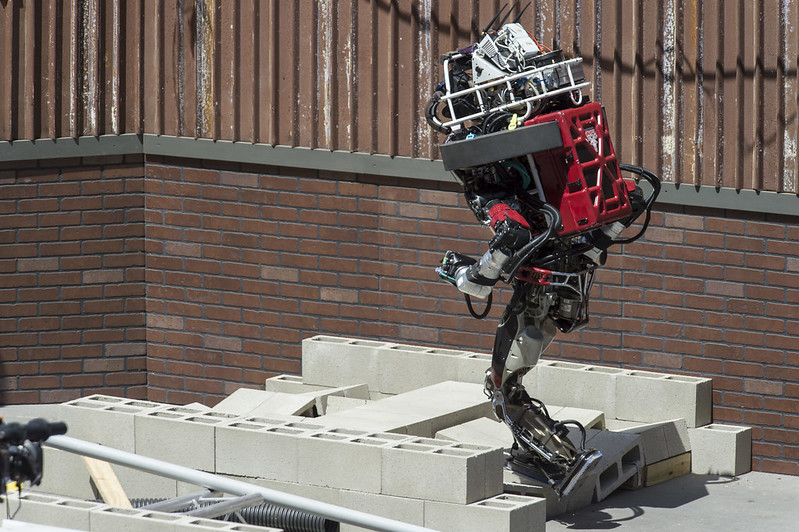
Defense & disaster response
Defense and disaster response applications are some of the most promising for humanoid robots. These are inherently dangerous applications, and in many cases it’s not at all feasible for humans to safely perform the work needed — for example, in the Fukushima nuclear power plant disaster.
Robots were sent into the plant to assess damages after a severe earthquake and tsunami, but they were unable to perform the full range of tasks human workers could. This led to the Defense Advanced Research Projects Agency (DARPA) to host competitions with the goal of accelerating humanoid robot development.
The DARPA competitions led to the development of the Atlas robot, one of the most advanced humanoid robots in terms of speed, mobility, and dexterity.
igus components for humanoid robots
One of the biggest barriers of entry for automation in general, especially for small and medium-sized businesses, is the cost of automation solutions. This is even more relevant in humanoid robots, where intense processing power is needed to enable the AI the robots are utilizing.
While the cost of processors may not be reduced in the near future, there’s another key area cost can be drastically minimized: motion components.
Motion components like plain bearings, slewing rings, and actuators are the building blocks of automated systems. Often, these are expensive metal components that require constant lubrication to perform optimally. This drives up the cost of the finished product, and often puts it out of reach of smaller businesses. However, high-performance plastic components can minimize these costs without sacrificing performance.
Components from igus are made with plastics embedded with solid lubricants to ensure consistent, grease-free lubrication for the entire life of the product. This minimizes maintenance and extends service life, all while reducing the initial cost due to the plastics used.
Online tools & calculators are also available to assist in configuring custom solutions using igus components. These tools offer highly accurate service life calculations as well, all based on extensive testing data gathered at the igus test lab in Cologne, Germany.
Looking forward
The humanoid robot industry is only getting started, but already it’s showing immense potential and receiving extensive support from major developers, integrators, manufacturers, and more. As awareness spreads and the technology improves, it’s likely humanoid robots will become a commodity in industrial applications, if not for personal use as well.


